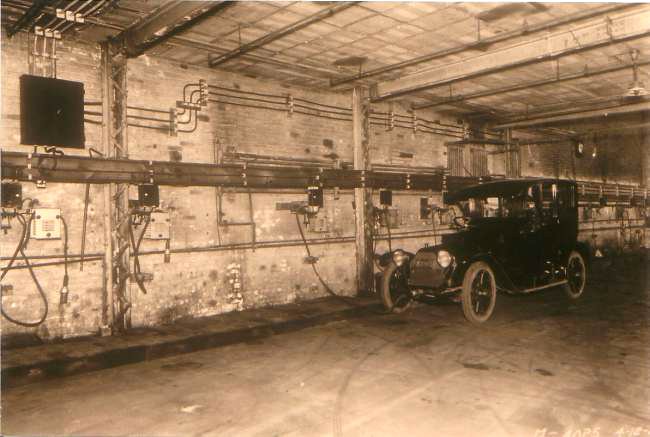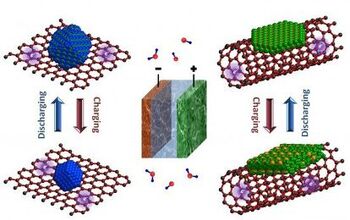Plus a Charge, Plus C'est La Mme Chose Pt. 3: Tesla's Supercharging Stations

A few months ago, BMW announced that it was throttling back (or should that be rheostating back?) on it’s “i” branded EV program, in part due to a lack of public charging station infrastructure. A company that sells as many gasoline and diesel powered cars as BMW does can afford to temper its enthusiasm for cars that run on electrons. A company that only sells battery powered electric cars, as Tesla does, doesn’t have that luxury.
If a lack of charging stations limits the rate of acceptance of EVs by consumers, well then, the businesses (and governments) with an interest in the growth of EV sales will just have to create that charging infrastructure, so Tesla just opened the first four of what is planned to be a nationwide network of more than 100 high speed charging stations that will let most Tesla Model S owners recharge their cars quickly, for free. While the notion of refueling your car at a station owned by the car’s manufacturer might seem a bit unusual, after all we don’t buy gasoline at Ford or Toyota filling stations, the idea is not really a new one, at least as far as electric cars are concerned. Tesla’s automaker owned charging stations were predated by over a century.
Electric cars were first popular a hundred years ago, and finding a place to charge your car was an issue then as well as now. Of course there weren’t gasoline stations on every corner then either so it wasn’t as much of a competitive disadvantage. Some people charged their cars at home – most urban areas of the United States had electric service by then. By 1914 General Electric had sold tens of thousands of mercury arc rectifier based EV chargers. Most of those chargers, it turns out, were installed in public charging stations, usually located in parking garages or at hotels. Some hotels also had dedicated curbside chargers for use by electric taxi cabs.
Until Tesla sells a few thousand more cars, the Detroit Electric, manufactured by the Anderson Carriage company and corporate successors, will still be the most successful electric car ever sold, at least in terms of units sold. About 20,000 Detroit Electrics were sold between 1907 and 1939. As a matter of fact, the Detroit Electric’s fortunes more or less parallel the early history of electric cars, peaking between 1910 and 1920, eventually overcome by the rapid technological improvements in internal combustion engines.
Just as Tesla is opening up a network of EV charging stations, a century ago Detroit Electric operated public charging stations for their customers (and others as well since most EVs of the era used a standard charging plug). Tesla is said to be locating their stations near trendy restaurants. A hundred years ago Detroit Electric also tried to accommodate their generally affluent customers (electric cars were significantly more expensive than typical gasoline powered cars) by locating company owned charging stations near where their customers lived, worked and played. In Detroit, there was a Detroit Electric showroom, repair garage and charging station near the foot of Woodward, another just across the bridge from the Belle Isle island park, and a third near the exclusive Boston-Edison residential district, nor far from where Henry and Clara Ford lived. Clara was not fond of “explosion” automobiles and like Helen Joy, the wife of Packard chief Henry Joy, Clara had her own Detroit Electric. The building for the charging station near Belle Isle still stands and is used by a theatrical prop company.
The charging stations were large, about 17,000 sq ft, and could accommodate charging more than 100 vehicles at a time. Detroit Electric offered a service where owners of Detroit Electric cars paid $35-$40 a month and their cars would be picked up, charged, washed, polished, given a complete mechanical inspection and then delivered back to the customer’s house. According to one inflation calculator, that works out to ~$800-$900 a month.
By 1912, Detroit Electric had sales branches and charging stations in Manhattan, Chicago , Boston, Brooklyn, Buffalo, Cleveland, Evanston, Kansas City, and Minneapolis. Route guides were published, showing the location of Detroit Electric and other public charging stations to show that electric cars were not just suitable for city use, by the Electric Vehicle Association, Goodrich tires and the Automobile Blue Book publishing company. The EVA even published a route guide for charging stations along the Lincoln Highway, America’s first transcontinental highway, though few EVs could have made the trip, as there was one leg with 190 miles between charging stations, a distance beyond the range of any electric cars made at the time. EV drivers were resourceful, though, and in a pinch they’d get a charge from the power cables used by electric streetcars.
Hope and the future promise of battery electric cars spring eternal. In the Feb. 1913 issue of Country Life in America (that also has an ad for REO automobiles penned by Ransom E. Olds himself), the publication’s automotive writer, one Ryland P. Madison, discussed the problems and promise of EVs in a manner that could be be repeated almost verbatim today:
Their well-known deficiency is a lack of ability to carry sufficient storage capacity to give long mileage at high speeds or under heavy loads… In the last three years there has been a marked improvement in storage batteries – so great that some engineers believe that electrics will be the universal car of the future.
Ronnie Schreiber edits Cars In Depth, a realistic perspective on cars & car culture and the original 3D car site. If you found this post worthwhile, you can dig deeper at Cars In Depth. If the 3D thing freaks you out, don’t worry, all the photo and video players in use at the site have mono options. Thanks for reading – RJS

Ronnie Schreiber edits Cars In Depth, the original 3D car site.
More by Ronnie Schreiber
Latest Car Reviews
Read moreLatest Product Reviews
Read moreRecent Comments
- ToolGuy First picture: I realize that opinions vary on the height of modern trucks, but that entry door on the building is 80 inches tall and hits just below the headlights. Does anyone really believe this is reasonable?Second picture: I do not believe that is a good parking spot to be able to access the bed storage. More specifically, how do you plan to unload topsoil with the truck parked like that? Maybe you kids are taller than me.
- ToolGuy The other day I attempted to check the engine oil in one of my old embarrassing vehicles and I guess the red shop towel I used wasn't genuine Snap-on (lots of counterfeits floating around) plus my driveway isn't completely level and long story short, the engine seized 3 minutes later.No more used cars for me, and nothing but dealer service from here on in (the journalists were right).
- Doughboy Wow, Merc knocks it out of the park with their naming convention… again. /s
- Doughboy I’ve seen car bras before, but never car beards. ZZ Top would be proud.
- Bkojote Allright, actual person who knows trucks here, the article gets it a bit wrong.First off, the Maverick is not at all comparable to a Tacoma just because they're both Hybrids. Or lemme be blunt, the butch-est non-hybrid Maverick Tremor is suitable for 2/10 difficulty trails, a Trailhunter is for about 5/10 or maybe 6/10, just about the upper end of any stock vehicle you're buying from the factory. Aside from a Sasquatch Bronco or Rubicon Jeep Wrangler you're looking at something you're towing back if you want more capability (or perhaps something you /wish/ you were towing back.)Now, where the real world difference should play out is on the trail, where a lot of low speed crawling usually saps efficiency, especially when loaded to the gills. Real world MPG from a 4Runner is about 12-13mpg, So if this loaded-with-overlander-catalog Trailhunter is still pulling in the 20's - or even 18-19, that's a massive improvement.






































Comments
Join the conversation
In 1915 it took all day to drive 100 miles because of the poor roads, low top speed capability, frequent tire repair stops, etc. Now it takes less than two hours to travel this distance. So what would be an overnight charge then is now a four or five time a day exercise.
You have to admit though that the battery technology has improved significantly. Model S has been driven from LA to San Diego and back at freeway speeds by Motor Trend. They also went from LA to Las Vegas and had 60 miles of range left over. Significantly more usable than the Detroit Electrics of the past.